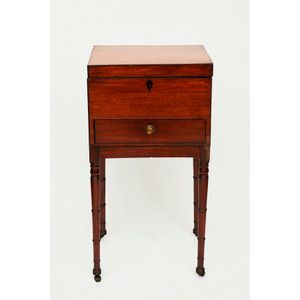George II Oak Side Table, Circa 1730
You must be a subscriber, and be logged in to view price and dealer details.
Subscribe Now to view actual auction price for this item
When you subscribe, you have the option of setting the currency in which to display prices to $Au, $US, $NZ or Stg.
- George Ii - George II (1683 - 1760) was King of Great Britain and Ireland from 1727 until his death in 1760.
- Circa - A Latin term meaning 'about', often used in the antique trade to give an approximate date for the piece, usually considered to be five years on either side of the circa year. Thus, circa 1900 means the piece was made about 1900, probably between 1895 and 1905. The expression is sometimes abbreviated to c.1900.
- Oak - Native to Europe and England, oak has been used for joinery, furniture and building since the beginning of the medieval civilisation. It is a pale yellow in colour when freshly cut and darkens with age to a mid brown colour.
Oak as a furniture timber was superceded by walnut in the 17th century, and in the 18th century by mahogany,
Semi-fossilised bog oak is black in colour, and is found in peat bogs where the trees have fallen and been preserved from decay by the bog. It is used for jewellery and small carved trinkets.
Pollard oak is taken from an oak that has been regularly pollarded, that is the upper branches have been removed at the top of the trunk, result that new branches would appear, and over time the top would become ball-like. . When harvested and sawn, the timber displays a continuous surface of knotty circles. The timber was scarce and expensive and was used in more expensive pieces of furniture in the Regency and Victorian periods. - Turning - Any part of a piece of furniture that has been turned and shaped with chisels on a lathe. Turned sections include legs, columns, feet, finials, pedestals, stretchers, spindles etc. There have been many varieties and fashions over the centuries: baluster, melon, barley-sugar, bobbin, cotton-reel, rope-twist, and so on. Split turning implies a turned section that has been cut in half lengthwise and applied to a cabinet front as a false decorative support.
- Turned Legs - are legs which have been turned on a lathe. In use from the 16th century, turned legs on tables, chairs and cabinets became more frequent until, by the 1830s, the Georgian square or tapered leg was rarely found except in country pieces.
This item has been included into following indexes:
Visually similar items

Mahogany tea caddy on stand, the rectangular box with ebony string inlay, one drawer below, on four turned legs, height 70.5 cm, width 35 cm, depth 25.5 cm

A Sheraton mahogany card table. Circa 1810. Rectangular form with satinwood banding and canted corners with a hinged top enclosing a beige interior on ring turned legs. Provenance: William Johnson, Kent Antique, High Street, Armadale. 70 cm high, 92 cm wid

A George II mahogany cellaret, 57 cm high, 49 cm wide, 28 cm deep

A George III oak side table, the top with thumbnail moulded edge raised on turned legs with stretcher base, one deep drawer to the front. Provenance: This table was gifted to the vendor's parents on their marriage in 1941 from Baden Powell's house. 80 x 53
